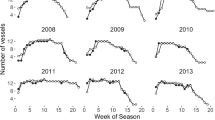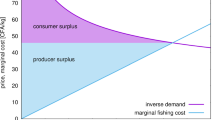Abstract
We analyze the optimal harvesting rule of a monopolist in a managed single-species fishery environment where we allow the fishery control to be imperfect. The monopolist’s control action consists of legal and illegal actions. Illegal actions might be detected at random times, in which case the monopolist is subject to a deterrence scheme in line with the Common Fishery Policy implemented by the European Union. We show that the introduction of the management policy, together with the inability of the regulator to perfectly monitor fishing activities, creates an incentive to harvest not only beyond the allowed quota, but also beyond the harvest in an unregulated but otherwise equal situation. This effect is particularly pronounced at lower levels of the legal quota. We also show that, if the monopolist is sufficiently impatient, over-harvesting with severe depletion of the resource might even occur under a reinforced deterrence scheme that considers the permanent withdrawal of the fishing license.




Similar content being viewed by others
Notes
The most common kind of target is the Maximum Sustainable Yield (MSY), defined as the largest average catch that can be continuously taken from a stock under existing environmental conditions. In 2002, during the Earth Summit, the EU member States committed themselves to “maintain or restore stocks to levels that produce the MSY with the aim of achieving these goals for depleted stocks on an urgent basis and where possible not later than 2015.” The European Common Fishery Policy (CFP) is based on achieving the MSY in most fisheries, as stated in the Green paper on the reform of the CFP, see http://ec.europa.eu/fisheries/reform/index_en.htm, last accessed on 29/11/2017.
One important example is the so-called management by reference points, which is commonly applied in many North American fisheries. For example, the 40–10 harvest control rule of the Pacific Coast Groundfish Fishery Management Plan (PCGFMP) imposes constant harvesting when biomass is above 40% of the virgin stock size, a progressive reduction in fishing effort when the biomass is between 10 and 40% and the closure of the fishery when biomass is below 10%, see [2] for an overview on HCRs and related real-world examples.
In 2013, it was estimated that illegal fishing represents between $10 billion to $23 billion in global losses each year, see: http://www.huffingtonpost.com/2013/05/08/illegal-fishing-fish-piracy-seafood_n_3234434.html, last accessed on 29/11/2017.
See the implementation of Council Regulation (EC) No 1224/2009 establishing a Community control system for ensuring compliance with the rules of the Common Fisheries Policy, available at http://eur-lex.europa.eu/legal-content/EN/ALL/?uri=CELEX:32009R1224, last accessed on 29/11/2017.
See http://ec.europa.eu/fisheries/cfp/control/infringements_sanctions/index_en.htm, last accessed on 29/11/2017.
In other words, an infinity of legal–illegal decisions takes place in a finite amount of time. As it is difficult for this to happen in reality, our model could be generalized following [27]. This involves considering the harvesting rate as a state variable and penalizing changes in effort in the objective function by introducing adjustment costs. We acknowledge an anonymous reviewer for pointing out such an extension.
We have performed a series of robustness check on various bioeconomic setups, all confirming our main findings, but we do not report the results in the paper for the sake of brevity.
References
Clark, C.W.: Mathematical Bioeconomics: The Mathematics of Conservation, 3rd edn. Wiley, London (2010)
Apostolaki, P., Hillary, R.: Harvest control rules in the context of fishery-independent management of fish stocks. Aquat. Living Resour. 22(2), 217–224 (2009)
Sumaila, U., Alder, J., Keith, H.: Global scope and economics of illegal fishing. Mar. Policy 30(6), 696–703 (2006)
Becker, G.: Crime and punishment: an economic approach. J. Political Econ. 76, 169–217 (1968)
Leung, S.: How to make the fine fit the corporate crime? An analysis of static and dynamic optimal punishment theories. J. Public Econ. 45, 243–256 (1991)
Motchenkova, E., Kort, P.: Analysis of current penalty schemes for violations of antitrust laws. J. Optim. Theory Appl. 128(2), 431–451 (2006)
Polinsky, A., Shavell, S.: The optimal tradeoff between the probability and magnitude of fines. Am. Econ. Rev. 69, 880–891 (1979)
Leung, S.: Dynamic deterrence theory. Economica 62, 65–87 (1995)
Garoupa, N.: The theory of optimal law enforcement. J. Econ. Surv. 11, 267–295 (1997)
Garoupa, N.: Optimal magnitude and probability of fines. Eur. Econ. Rev. 45, 1765–1771 (2001)
Sutinen, J., Andersen, P.: The economics of fisheries law enforcement. Land Econ. 61, 387–397 (1985)
Furlong, W.: The deterrent effect of regulatory enforcement in the fishery. Land Econ. 67(1), 116–129 (1991)
Milliman, S.: Optimal fishery management in the presence of illegal activity. J. Environ. Econ. Manag. 13(4), 363–381 (1986)
Nøstbakken, L.: Fisheries law enforcement—a survey of the economic literature. Mar. Policy 32(3), 293–300 (2008)
Frank, K., Petrie, B., Fisher, J., Leggett, W.: Transient dynamics of an altered large marine ecosystem. Nature 477(7362), 86–89 (2011)
Clark, C., Munro, G.: The economics of fishing and modern capital theory: a simplified approach. J. Environ. Econ. Manag. 2, 92–106 (1975)
Fleming, W., Soner, H.: Controlled Markov Processes and Viscosity Solutions. Springer, Berlin (2006)
Grüne, L., Semmler, W.: Using dynamic programming with adaptive grid scheme for optimal control problems in economics. J. Econ. Dyn. Control 28, 2427–2456 (2004)
Santos, M.S., Vigo-Aguiar, J.: Analysis of a numerical dynamic programming algorithm applied to economic models. Econometrica 66(2), 409–426 (1998)
Camilli, F.: Approximation of integro-differential equations associated with piecewise deterministic process. Optim. Control Appl. Methods 18, 423–444 (1997)
Bischi, G., Lamantia, F., Radi, D.: Multispecies exploitation with evolutionary switching of harvesting strategies. Nat. Resour. Model. 26(4), 546–571 (2013)
Clark, C.W.: The Worldwide Crisis in Fisheries. Cambridge University Press, Cambridge (2007)
Utkin, V.: Variable structure systems with sliding modes. IEEE Trans. Autom. Control AC 22, 212–222 (1977)
Filippov, A.: Differential Equations with Discontinuous Righthand Sides. Kluwer, Dordrecht (1988)
Di Bernardo, M., Budd, C., Champneys, A., Kowalczyk, P.: Piecewise-Smooth Dynamical Systems: Theory and Applications. Springer, Berlin (2008)
Bischi, G., Lamantia, F., Tramontana, F.: Sliding and oscillations in fisheries with on-off harvesting and different switching times. Commun. Nonlinear Sci. Numer. Simul. 19, 216–219 (2014)
Jørgensen, S., Kort, P.M.: Optimal dynamic investment policies under concave–convex adjustment costs. J. Econ. Dyn. Control 17(1), 153–180 (1993)
Acknowledgements
The authors wish to thank the Editors and the anonymous Reviewers for insightful comments and suggestions. The usual disclaimer applies.
Author information
Authors and Affiliations
Corresponding author
Rights and permissions
About this article
Cite this article
De Giovanni, D., Lamantia, F. Dynamic Harvesting Under Imperfect Catch Control. J Optim Theory Appl 176, 252–267 (2018). https://doi.org/10.1007/s10957-017-1208-y
Received:
Accepted:
Published:
Issue Date:
DOI: https://doi.org/10.1007/s10957-017-1208-y




